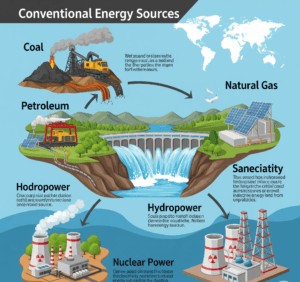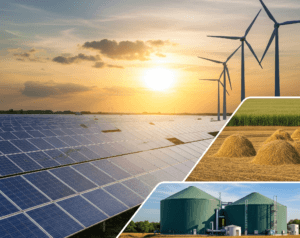ENERGY: Meaning and Importance
Energy is the fundamental requirement for all forms of work—by both humans and nature. Every action, from moving vehicles to growing plants, is a transformation of energy from one form to another.
Key Points:
- Energy exists in various forms (mechanical, electrical, thermal, chemical).
- It drives all economic, physical, and biological processes.
- Human civilization depends on a continuous and efficient energy supply.
Stages of Technical Energy Conversion
Energy passes through three main stages before it is used effectively:
- Primary Energy
- It is the raw energy obtained directly from natural sources.
- Unprocessed and original.
- Examples:
- Crude oil
- Coal
- Natural uranium
- Solar radiation
- Wind energy
- Final (Secondary) Energy
- This is energy that has been processed or refined from primary energy.
- It is the form that is delivered to consumers.
- Examples:
- Electricity
- Gasoline
- Steam
- Fuel oil
- Effective Energy
- Also known as useful energy.
- This is the form in which energy is finally used to perform work.
- Examples:
- Light (from electric bulbs)
- Heat (for cooking or heating)
- Motion (for vehicles or machinery)
Classification of Energy Sources
Energy sources can be categorized based on various criteria:
A) Based on Usability
1. Commercial Energy Sources
- Require high capital investment.
- Are often non-renewable and imported.
- Widely used in industries and urban sectors.
- Examples:
- Petrol
- Diesel
- Electricity
2. Non-Commercial Energy Sources
- Low-cost, usually locally available.
- Widely used in rural and agricultural settings.
- Examples:
- Human labor
- Animal power (bullocks)
B. Based on Traditional Use

- Conventional Energy Sources
- Used traditionally for many decades.
- Usually non-renewable.
- Examples:
- Fossil fuels (coal, petroleum)
- Hydro power
- Nuclear power
- Non-Conventional Energy Sources

- Gained importance after oil crisis of 1973.
- Focus on sustainable and clean alternatives.
- Examples:
- Solar energy
- Wind energy
- Biomass energy
C. Based on Long-Term Availability
- Non-Renewable (Exhaustible) Resources
- Limited supply, cannot be replenished.
- Their excessive use leads to depletion.
- Examples:
- Coal
- Petroleum
- Natural gas
- Uranium (for nuclear energy)
- Renewable Resources
- Naturally replenished.
- Environmentally friendly and sustainable.
- Examples:
- Solar
- Wind
- Hydro
- Biomass
- Geothermal
D. Based on Origin
Energy sources can also be identified based on their natural origin:
- Fossil Fuel
- Wind Energy
- Solar Energy
- Biomass Energy
- Nuclear Energy
- Geothermal Energy
- Tidal Energy
- Hydro Energy
Introduction to Renewable Energy
Definition: Renewable energy comes from resources that are naturally replenished and are inexhaustible on a human time scale.
Examples:
- Sunlight
- Wind
- Water (hydro, tidal)
- Biomass
- Geothermal
Importance:
- Helps reduce dependency on fossil fuels.
- Reduces environmental pollution.
- Supports decentralized energy systems (energy generation near point of use).
Technologies/Applications of Renewable Energy
|
Source |
Technology/Application |
|
Solar |
– Photovoltaic cells convert sunlight into electricity |
|
Wind |
– Wind turbines generate electricity or pump water |
|
Hydropower |
– Dams and turbines generate electricity from water flow |
|
Biomass |
– Organic waste converted to biogas or used directly for heating and electricity |
|
Geothermal |
– Earth’s heat used for power generation and heating |
|
Ocean Energy |
– Wave and tidal energy converted to electricity using turbines or heat engines |
Advantages of Renewable Energy
- Inexhaustible – Naturally available and replenished.
- Low Running Costs – No fuel cost; minimal operation costs.
- Decentralized Use – Ideal for rural/remote areas.
- Eco-Friendly – Little or no pollution.
- Simple Systems – Can be built and maintained using local materials and labor.
- Employment Generation – Promotes local job creation.
- Foreign Exchange Saving – Reduces fuel imports.
- Minimal Transmission Losses – Can be used at the generation site.
Disadvantages of Renewable Energy
- Low Energy Density – Requires large installations to produce significant energy.
- Intermittent Supply – Sunlight and wind are not always available.
- Lower Efficiency – Often operate at lower temperatures, reducing output.
- High Initial Investment – Equipment like solar panels or wind turbines can be expensive.
- Energy-Intensive Setup – Some components require high energy inputs during manufacturing.
- Thermal Pollution – Inefficient systems may release excess heat.
- Large Land Requirement – Renewable plants may occupy significant space, especially solar farms and biomass units.

